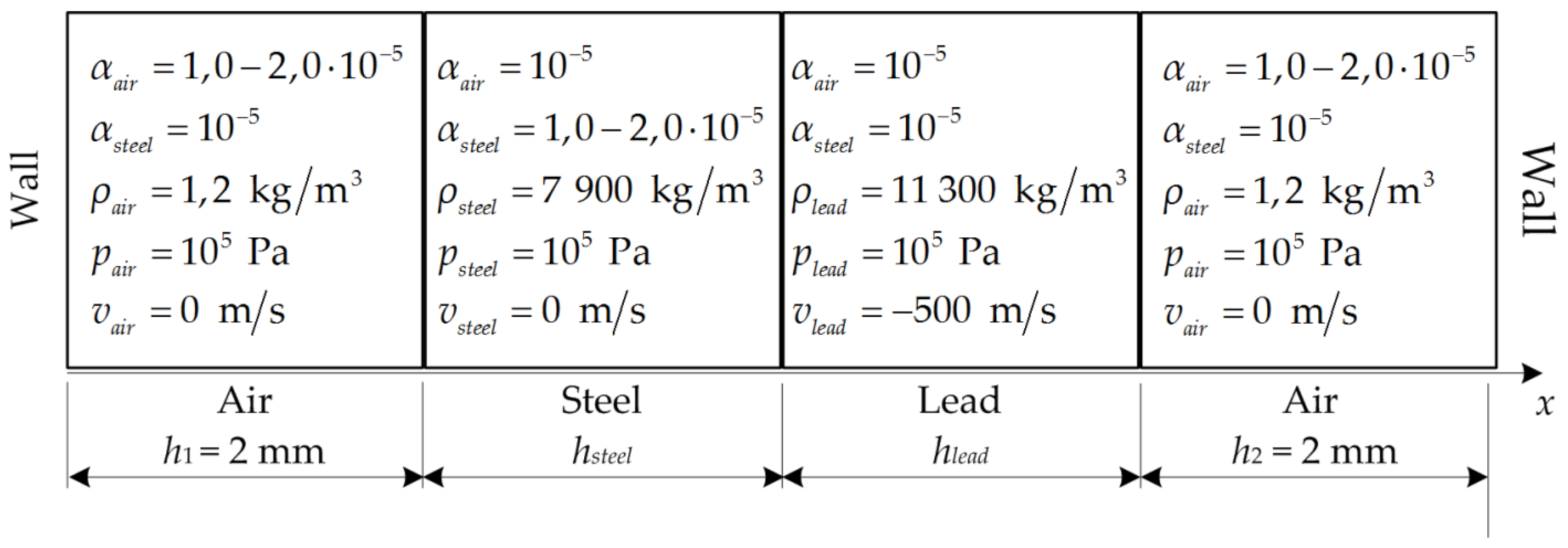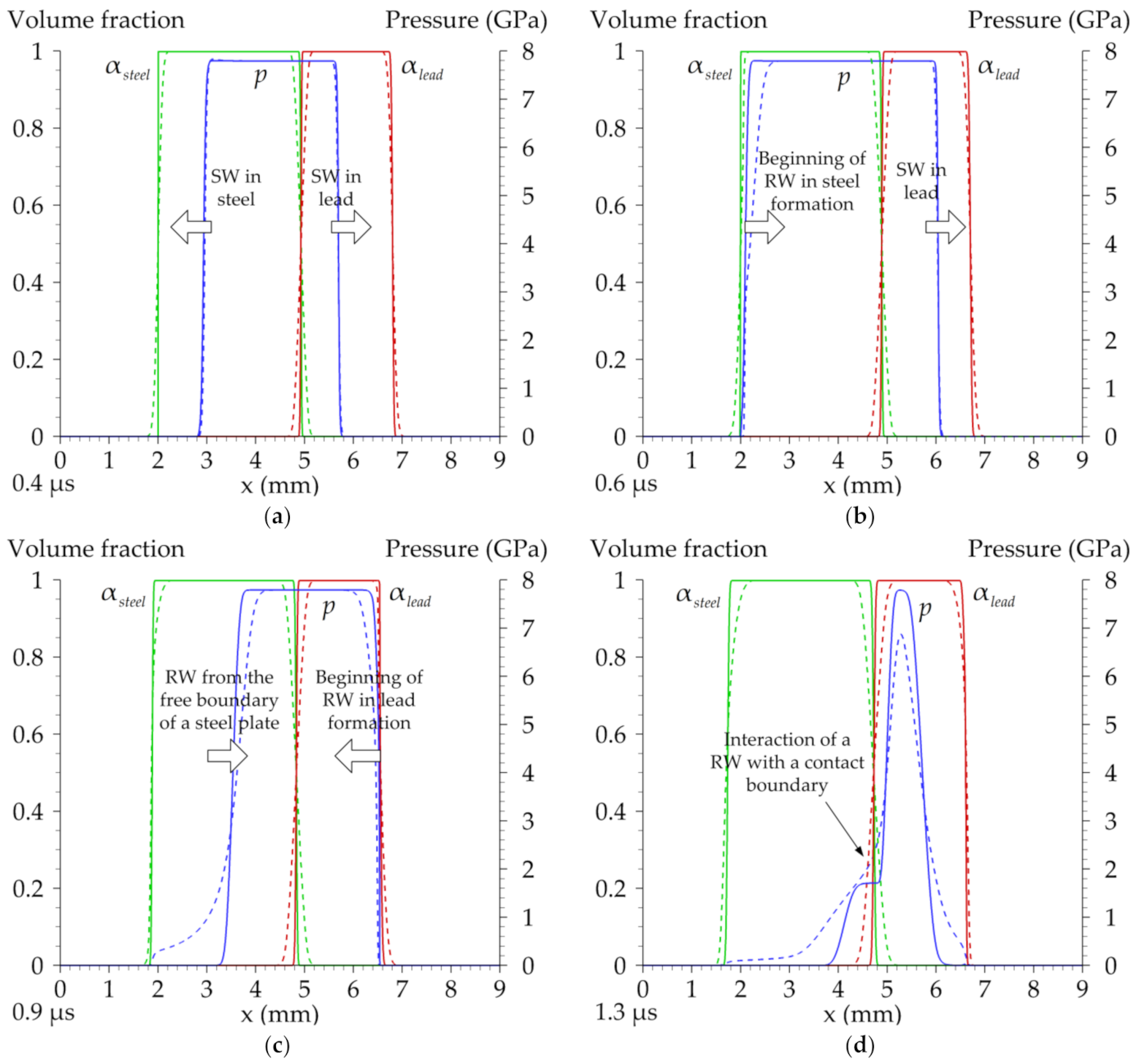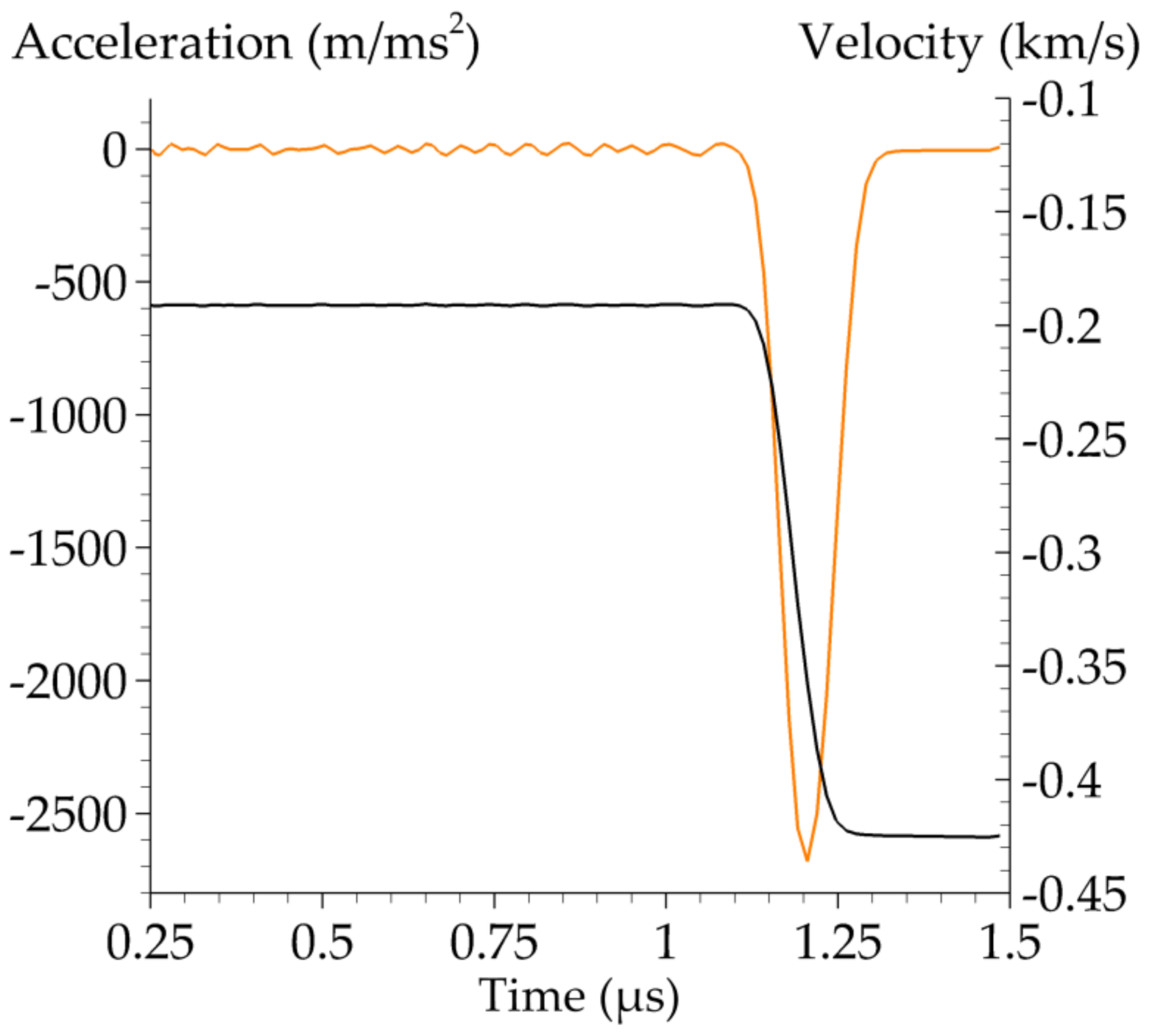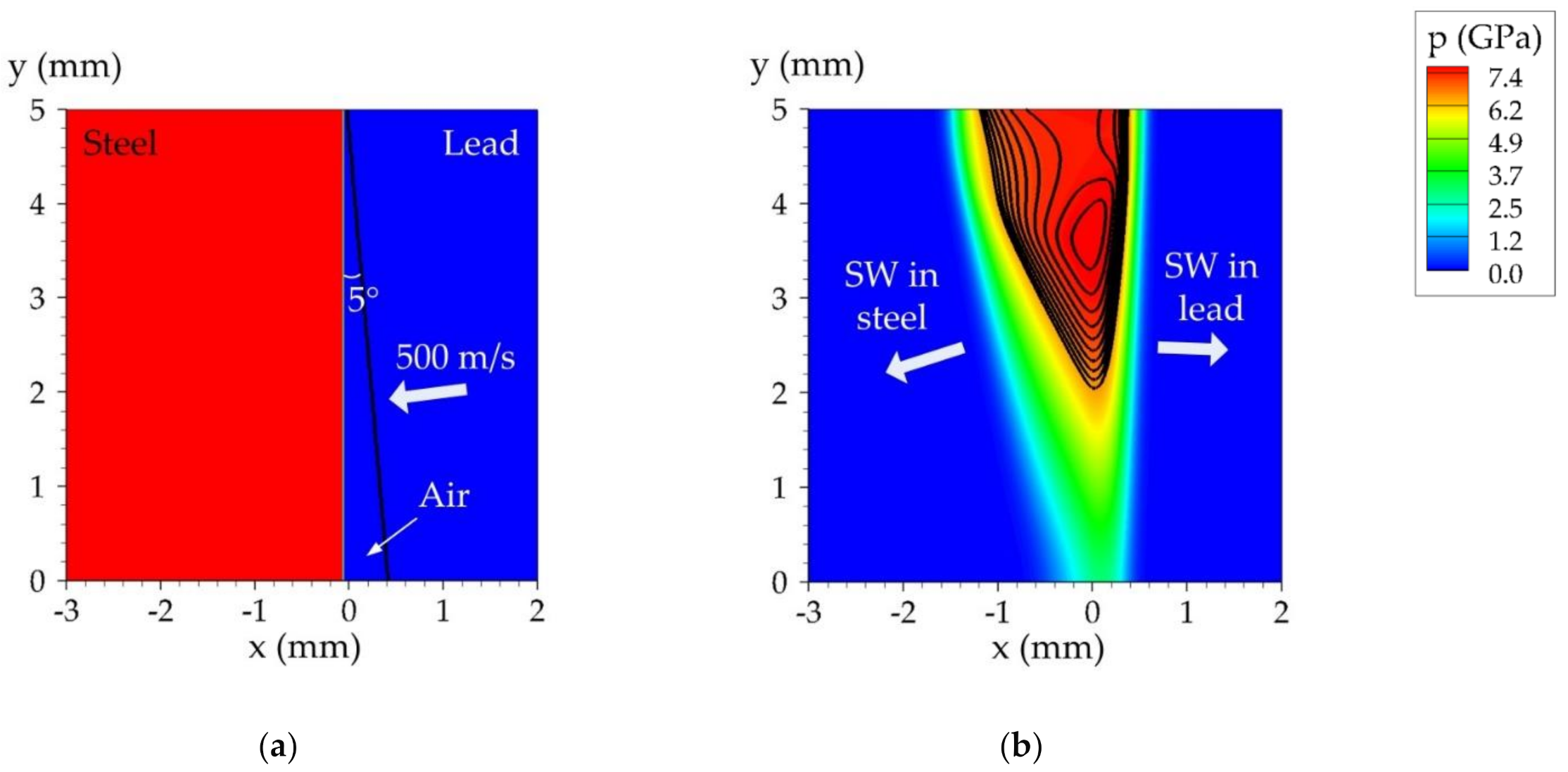Numerical Simulation of a High-Speed Impact of Metal Plates Using a Three-Fluid Model
Abstract
:1. Introduction
2. Physical Statement of the Problem
3. Mathematical Model
4. Numerical Algorithm
4.1. Splitting Scheme
4.2. Hyperbolic Step
4.2.1. HLL Method
4.2.2. HLLC Method
4.3. Velocity Relaxation
4.4. Pressure Relaxation
5. Simulation Results
6. Discussion
7. Conclusions
Author Contributions
Funding
Institutional Review Board Statement
Informed Consent Statement
Data Availability Statement
Conflicts of Interest
Nomenclature
| volume fraction | pressure relaxation parameter | ||
| density | velocity relaxation parameter | ||
| velocity | air | subscript for the air parameters | |
| pressure | steel | subscript for the steel parameters | |
| specific total energy | lead | subscript for the lead parameters | |
| specific internal energy | i | subscript for the interfacial parameters |
References
- Godunov, S.; Deribas, A.; Zabrodin, A.; Kozin, N. Hydrodynamic effects in colliding solids. J. Comput. Phys. 1970, 5, 517–539. [Google Scholar] [CrossRef]
- Deribas, A. Physics of Hardening and Welding by Explosion; Nauka: Novosibirsk, Russia, 1972. [Google Scholar]
- Bataev, I.; Tanaka, S.; Zhou, Q.; Lazurenko, D.; Junior, A.J.; Hokamoto, K.; Mori, A.; Chen, P. Towards better understanding of explosive welding by combination of numerical simulation and experimental study. Mater. Des. 2019, 169, 107649. [Google Scholar] [CrossRef]
- Kaya, Y. Investigation of Copper-Aluminium Composite Materials Produced by Explosive Welding. Metals 2018, 8, 780. [Google Scholar] [CrossRef] [Green Version]
- Wang, H.; Wang, Y. High-Velocity Impact Welding Process: A Review. Metals 2019, 9, 144. [Google Scholar] [CrossRef] [Green Version]
- Carvalho, G.H.S.F.L.; Galvão, I.; Mendes, R.; Leal, R.M.; Loureiro, A. Aluminum-to-Steel Cladding by Explosive Welding. Metals 2020, 10, 1062. [Google Scholar] [CrossRef]
- Malakhov, A.Y.; Saikov, I.V.; Denisov, I.V.; Niyezbekov, N.N. AlMg6 to Titanium and AlMg6 to Stainless Steel Weld Interface Properties after Explosive Welding. Metals 2020, 10, 1500. [Google Scholar] [CrossRef]
- Yakovlev, I.V. Instability of the interface between colliding metals. Combust. Explos. Shock. Waves 1975, 9, 390–393. [Google Scholar] [CrossRef]
- Saurel, R.; Abgrall, R. A Multiphase Godunov Method for Compressible Multifluid and Multiphase Flows. J. Comput. Phys. 1999, 150, 425–467. [Google Scholar] [CrossRef]
- Favrie, N.; Gavrilyuk, S. Diffuse interface model for compressible fluid—Compressible elastic–plastic solid interaction. J. Comput. Phys. 2012, 231, 2695–2723. [Google Scholar] [CrossRef]
- Baer, M.; Nunziato, J. A two-phase mixture theory for the deflagration-to-detonation transition (ddt) in reactive granular materials. Int. J. Multiph. Flow 1986, 12, 861–889. [Google Scholar] [CrossRef]
- Zeidan, D.; Bähr, P.; Farber, P.; Gräbel, J.; Ueberholz, P. Numerical investigation of a mixture two-phase flow model in two-dimensional space. Comput. Fluids 2019, 181, 90–106. [Google Scholar] [CrossRef]
- Goncalves, E.; Hoarau, Y.; Zeidan, D. Simulation of shock-induced bubble collapse using a four-equation model. Shock. Waves 2018, 29, 221–234. [Google Scholar] [CrossRef] [Green Version]
- Saurel, R.; Lemetayer, O. A multiphase model for compressible flows with interfaces, shocks, detonation waves and cavitation. J. Fluid Mech. 2001, 431, 239–271. [Google Scholar] [CrossRef]
- Hérard, J.-M. A three-phase flow model. Math. Comput. Model. 2007, 45, 732–755. [Google Scholar] [CrossRef] [Green Version]
- Abrahamson, G.R. Permanent Periodic Surface Deformations Due to a Traveling Jet. J. Appl. Mech. 1961, 28, 519–528. [Google Scholar] [CrossRef]
- Meng, B.; Zeng, J.; Tian, B.; Li, L.; He, Z.; Guo, X. Modeling and verification of the Richtmyer–Meshkov instability linear growth rate of the dense gas-particle flow. Phys. Fluids 2019, 31, 074102. [Google Scholar] [CrossRef]
- Mader, C.L. Numerical Modeling of Explosives and Propellants; CRC Press: Boca Raton, FL, USA, 2008. [Google Scholar]
- Utkin, P.S.; Fortova, S.V. Mathematical modeling of impact of two metal plates using two-fluid approach. J. Phys. Conf. Ser. 2018, 946, 012047. [Google Scholar] [CrossRef]
- Utkin, P.S.; Fortova, S.V. Mathematical Modeling of High-Speed Interaction of Metallic Plates within the Two-Fluid Euler Approach. Comput. Math. Math. Phys. 2018, 58, 1377–1383. [Google Scholar] [CrossRef]
- Fortova, S.V.; Utkin, P.S.; Kazakova, T.S. Three-Dimensional Numerical Simulation of the Development of Instability of a Contact Boundary of Colliding Metal Plates within the Gas-Dynamic Approximation. High Temp. 2019, 57, 236–241. [Google Scholar] [CrossRef]
- Kanel, G.I.; Razorenov, S.; Baumung, K.; Singer, J. Dynamic yield and tensile strength of aluminum single crystals at temperatures up to the melting point. J. Appl. Phys. 2001, 90, 136–143. [Google Scholar] [CrossRef]
- Povarnitsyn, M.; Khishchenko, K.; Levashov, P. Hypervelocity impact modeling with different equations of state. Int. J. Impact Eng. 2006, 33, 625–633. [Google Scholar] [CrossRef]
- Lochon, H.; Daude, F.; Galon, P.; Hérard, J.-M. HLLC-type Riemann solver with approximated two-phase contact for the computation of the Baer–Nunziato two-fluid model. J. Comput. Phys. 2016, 326, 733–762. [Google Scholar] [CrossRef] [Green Version]
- Hennessey, M.; Kapila, A.; Schwendeman, D. An HLLC-type Riemann solver and high-resolution Godunov method for a two-phase model of reactive flow with general equations of state. J. Comput. Phys. 2020, 405, 109180. [Google Scholar] [CrossRef]
- Abgrall, R. How to Prevent Pressure Oscillations in Multicomponent Flow Calculations: A Quasi Conservative Approach. J. Comput. Phys. 1996, 125, 150–160. [Google Scholar] [CrossRef] [Green Version]
- Qiang, L.; Jian-Hu, F.; Ti-Min, C.; Chun-Bo, H. Difference scheme for two-phase flow. Appl. Math. Mech. 2004, 25, 536–545. [Google Scholar] [CrossRef]
- Liang, S.; Liu, W.; Yuan, L. Solving seven-equation model for compressible two-phase flow using multiple GPUs. Comput. Fluids 2014, 99, 156–171. [Google Scholar] [CrossRef]
- Furfaro, D.; Saurel, R. A simple HLLC-type Riemann solver for compressible non-equilibrium two-phase flows. Comput. Fluids 2015, 111, 159–178. [Google Scholar] [CrossRef]
- Utkin, P.S. Mathematical Modeling of the Interaction of a Shock Wave with a Dense Cloud of Particles within the Framework of the Two-Fluid Approach. Russ. J. Phys. Chem. B 2017, 11, 963–973. [Google Scholar] [CrossRef]
- Utkin, P. Numerical simulation of shock wave—Dense particles cloud interaction using Godunov solver for Baer–Nunziato equations. Int. J. Numer. Methods Heat Fluid Flow 2019, 29, 3225–3241. [Google Scholar] [CrossRef]
- Poroshyna, Y.; Utkin, P. Numerical simulation of a normally incident shock wave—Dense particles layer interaction using the Godunov solver for the Baer–Nunziato equations. Int. J. Multiph. Flow 2021, 142, 103718. [Google Scholar] [CrossRef]
- Fortov, V.; Kim, V.; Lomonosov, I.; Matveichev, A.; Ostrik, A. Numerical modeling of hypervelocity impacts. Int. J. Impact Eng. 2006, 33, 244–253. [Google Scholar] [CrossRef]
- Fortov, V.; Khishchenko, K.; Levashov, P.; Lomonosov, I. Wide-range multi-phase equations of state for metals. Nucl. Instrum. Methods Phys. Res. Sect. A 1998, 415, 604–608. [Google Scholar] [CrossRef]
- Shock Wave Database. Available online: http://www.ihed.ras.ru/rusbank/ (accessed on 22 June 2021).
- Li, X.; Wang, Y.; Wang, X.; Yan, H.; Zeng, X.; Wang, J. Gas shock waves in the gap between the base and cladding plates during explosive welding. Explos. Shock. Waves 2021, 41, 075301. [Google Scholar] [CrossRef]
- Skews, B.W.; Ndebele, B. Fluid Dynamics Associated with Body Impact. J. Appl. Fluid Mech. 2021, 14, 993–1002. [Google Scholar] [CrossRef]
- Nassiri, A.; Kinsey, B. Numerical studies on high-velocity impact welding: Smoothed particle hydrodynamics (SPH) and arbitrary Lagrangian–Eulerian (ALE). J. Manuf. Process. 2016, 24, 376–381. [Google Scholar] [CrossRef] [Green Version]
- Kiselev, S.P.; Mali, V.I. Numerical and experimental modeling of jet formation during a high-velocity oblique impact of metal plates. Combust. Explos. Shock. Waves 2012, 48, 214–225. [Google Scholar] [CrossRef]
- Godunov, S.K.; Kiselev, S.P.; Kulikov, I.M.; Mali, V. Numerical and experimental simulation of wave formation during explosion welding. Proc. Steklov Inst. Math. 2013, 281, 12–26. [Google Scholar] [CrossRef]




| No. | hsteel, mm | τsteel, μs | τlead, μs | Tsteel, μs | Tlead, μs |
|---|---|---|---|---|---|
| 1 | 2 | 0.38 | 0.8 | 0.70 | – |
| 2 | 3 | 0.54 | 1.05 | – | |
| 3 | 4 | 0.72 | 1.38 | 1.38 | |
| 4 | 4.5 | 0.82 | – | 1.38 | |
| 5 | 5 | 0.91 | – | 1.38 | |
| 6 | 10 | 1.85 | – | 1.38 | |
| 7 | 20 | × | – | 1.38 |
Publisher’s Note: MDPI stays neutral with regard to jurisdictional claims in published maps and institutional affiliations. |
© 2021 by the authors. Licensee MDPI, Basel, Switzerland. This article is an open access article distributed under the terms and conditions of the Creative Commons Attribution (CC BY) license (https://creativecommons.org/licenses/by/4.0/).
Share and Cite
Chuprov, P.; Utkin, P.; Fortova, S. Numerical Simulation of a High-Speed Impact of Metal Plates Using a Three-Fluid Model. Metals 2021, 11, 1233. https://doi.org/10.3390/met11081233
Chuprov P, Utkin P, Fortova S. Numerical Simulation of a High-Speed Impact of Metal Plates Using a Three-Fluid Model. Metals. 2021; 11(8):1233. https://doi.org/10.3390/met11081233
Chicago/Turabian StyleChuprov, Petr, Pavel Utkin, and Svetlana Fortova. 2021. "Numerical Simulation of a High-Speed Impact of Metal Plates Using a Three-Fluid Model" Metals 11, no. 8: 1233. https://doi.org/10.3390/met11081233
APA StyleChuprov, P., Utkin, P., & Fortova, S. (2021). Numerical Simulation of a High-Speed Impact of Metal Plates Using a Three-Fluid Model. Metals, 11(8), 1233. https://doi.org/10.3390/met11081233







